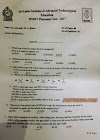Click on the tabs to see the Detailed Syllabus:
Module Details
| Module Code | HNDIT1104 |
|---|---|
| Module Title | Data Representation & Organization |
| Credits | 2 |
| Hours /Week |
Lectures - 15 Lab/Tutorial - 30 |
| Semester | 1 |
| GPA/NGPA | GPA |
| Module Type | Core Compulsory |
Module Aims & Objectives
To enable the students to understand and describe how information and data are represented
inside a computer system.
Learning Outcomes
At the end of the module the student will be able to:
▪ Describe the terms data, information, Weighted and non-weighted number systems.
▪ Describe and use different number formats and convert data between different number formats.
▪ Describe and use appropriate coding schemes for data representation.
▪ Describe and determine the precision and range associated with different numerical representation.
▪ Select appropriate coding and data representation scheme for a given application considering their advantages, disadvantages and limitations.
▪ Describe the terms data, information, Weighted and non-weighted number systems.
▪ Describe and use different number formats and convert data between different number formats.
▪ Describe and use appropriate coding schemes for data representation.
▪ Describe and determine the precision and range associated with different numerical representation.
▪ Select appropriate coding and data representation scheme for a given application considering their advantages, disadvantages and limitations.
Outline Syllabus
1. Basic-Weighted and non-weightednumbersystems and
Decimalrepresentationofnumericalvaluesandthe theory
/conceptbehinddecimalnumber system.
2. Logic gates and Boolean algebra.
3. Different types of number systems and symbols. Decimal to Binary Conversions / Octal / Hexadecimal (& vice versa) and binary to Octal and Hexadecimal (& vice versa). Binary Operations.
4. Signed Integer Representation (Signed Magnitude, Complement Systems and basic arithmetic).
5. Fixed and Floating-Point Representation.
6. Character Codes (BCD, EBCDIC, ASCII, UNICODE)
2. Logic gates and Boolean algebra.
3. Different types of number systems and symbols. Decimal to Binary Conversions / Octal / Hexadecimal (& vice versa) and binary to Octal and Hexadecimal (& vice versa). Binary Operations.
4. Signed Integer Representation (Signed Magnitude, Complement Systems and basic arithmetic).
5. Fixed and Floating-Point Representation.
6. Character Codes (BCD, EBCDIC, ASCII, UNICODE)
Assessments
| Type | Activity | Weighting |
|---|---|---|
| Continuous Assessment | In-class discussions, group work, Quizzes, Assignments and tutorials | 50% |
| Semester Examination | Final Structured Paper | 50% |
Recommended Learning Activities
Classroom teaching of theoretical subject matter supported by :
group presentation
Discussions
Assignments
Tutorials
Discussions
Assignments
Tutorials
Resources: Equipment, Tools and Materials
No special equipment required. However access to internet and reference text book will be useful.





0 Comments